The ultimate guide to creating a cohort program
Thinking about hosting a cohort-style experience? It’s a great idea! Cohort programs can be an amazing way to engage your members and guide them to some desired outcome or transformation.
What is a cohort program? A “cohort program” is a time-bound educational experience that supports members in unlocking some transformation together. The “together” part of that definition is important: Because members are going through the experience together, they’re able to learn from and support one another, form real and lasting connections, and help hold each other accountable throughout the experience.
FYI: A cohort program can also be referred to as a cohort course, cohort class, or a bootcamp!
Our team has learned a ton from hosting cohort based learning experiences in the Circle community, and now we’re sharing it all.
In this guide, I’ll walk through the key steps involved in planning, launching, and hosting a truly impactful cohort program using real examples of bootcamps we’ve hosted in the Circle community.
How to plan a cohort based learning experience
Before you can do anything else, it’s important to get clear on who you’re serving, how you’re serving them, and why. You might be tempted to skip this step, but don’t: Once you have clarity on this, all of the following steps will feel ten times easier.
Let’s explore these questions in more detail…
➡️ Why do you want to host a cohort program?
Are you hoping to deliver value to your community in a new way? Facilitate some transformation for members? Carve out a space where they can connect with one another?
We created Community Growth Catalyst because we knew that our members were
struggling with marketing their communities and attracting new members. It was
a topic we hadn’t comprehensively addressed before, and we knew that members
would benefit from a longer experience that taught them about different
community marketing strategies with built-in accountability.
➡️ Who are you hoping to serve with this cohort program?
It’s possible that not all of your community members will be a fit for your cohort program, and that’s perfectly OK.
When we hosted CGC, we knew that it would be most impactful for members with active communities who felt lost when it came to marketing. We also knew that it wouldn’t be as impactful for members who were still in the pre-launch phase or those who already felt confident in their marketing strategies. And we were fine with that: We knew that if we made it too general, it wouldn’t provide real value to anyone.
When you know who your program is and isn’t for, and position it accordingly, you’ll be able to drive real impact for the right members. (For further proof of this point, check out this sweet note one CGC participant sent us: “This is the most impactful course I've ever attended because I think it was perfectly pitched at my current problem set.” That’s the power of knowing exactly who your cohort program is for!)
➡️ What outcome do you hope to deliver to participants through this cohort program?
Is there a specific result or transformation that the cohort program will guide members through? (Spoiler: There absolutely should be.)
In CGC, our aim was to help bootcamp programers gain confidence in their marketing skills by having them test and implement proven community marketing strategies over the course of one month. So, the tangible outcome for participants was increased confidence in their marketing skills.
Check out how we framed this outcome when we announced the cohort program.
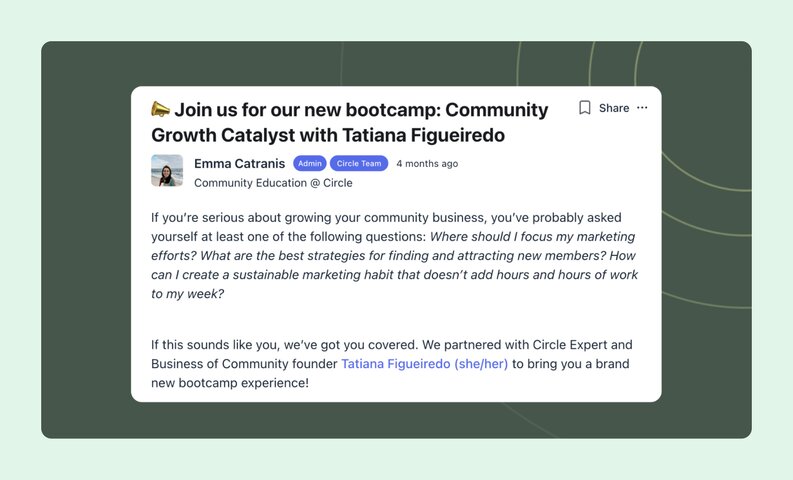
➡️ What will you title your cohort program?
The last foundational planning step is to title your cohort experience. Don’t overthink this or try to be too clever, punny, or abstract, or you’ll confuse your members.
If you’re stuck here, revisit your response to the “What outcome do you hope to deliver to participants through this cohort program?” question. Are there any words or phrases that stand out to you? Any concept you can use as a starting point? A strong title should underscore the value members will receive from participating.
Determine your format, touchpoints, and incentives
If you’ve made it this far, congrats! You’ve done the hardest part: Ironing out the fundamentals of your cohort experience. Now, you can move along to the fun part: Plotting out how you’ll actually deliver that experience.
➡️ What format will your cohort program take?
In the Circle community, we’ve tested out several different bootcamp style formats.
- For our Community Growth Catalyst program, we hosted live weekly masterclass sessions and dove deep into a specific marketing strategy each week.
- For our Community Business Blueprint program, we had participants work through a self-paced course in their own time (with clear instructions on which modules to complete each week) and supplemented that with live weekly office hours sessions.
There’s no one “correct” format — there’s only the format that works best for you, your members, and the outcome you’re trying to deliver. If you’re stumped, think through the following:
- What format will best enable me to facilitate the desired transformation for members?
- What format will best meet the needs of my members? (E.g. If your members are busy moms, perhaps leading with a self-paced course that they can work through during nap times is a good fit!)
- What format best suits my own needs, timeline, and resources? (E.g. If you’re looking to launch a cohort program ASAP, you might not have time to create a self-paced course.)
➡️ What other cohort touchpoints will you offer?
Will you offer members a discussion space where they can connect with one another and share updates on their progress? Will you offer supplemental office hours, coaching sessions, etc. as part of the program? Will you create any supplemental materials to support participants, such as workbooks, templates, or tutorials?
For CGC, our 4 touchpoints were:
- A cohort kickoff event
- Four masterclass sessions
- A discussion space where members were able to connect and discuss their progress and challenges
- A workbook where they could track their marketing efforts
Check out how we structured our CGC spaces to facilitate these touchpoints… (Heads up: We’ll dive deeper into spaces later in this post.)
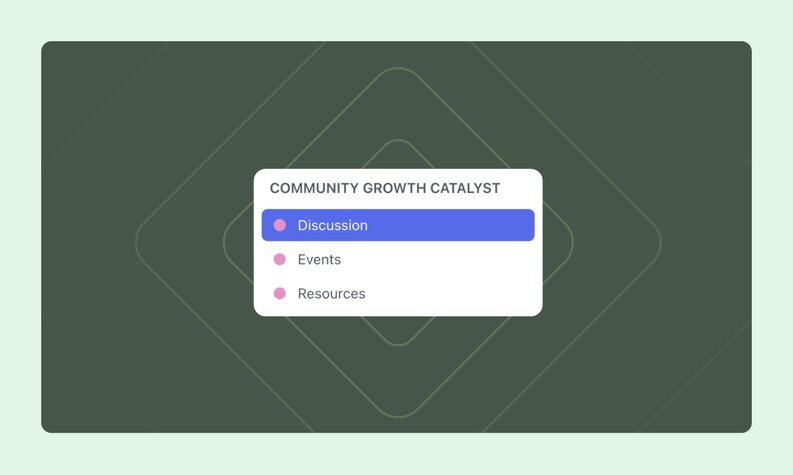
➡️ Will you offer prizes or incentives to encourage sustained participation?
This step is entirely optional. In many cases, the transformation itself is incentive enough to keep members engaged. In other cases, you might need to sweeten the deal to keep members motivated and engaged enough to actually unlock that transformation.
In the Circle community, we like to offer prizes to encourage sustained participation throughout the entire cohort training. We do this primarily because our members aren’t investing specifically in the cohort program: Access to the Circle community (and Circle community training programs) is included when you purchase a Circle plan. So while many of our community members are eager and excited to engage, others join with fairly low intent to participate because there’s nothing on the line if they don’t complete the program. We’ve found that prizes are a good way to counter this behavior.
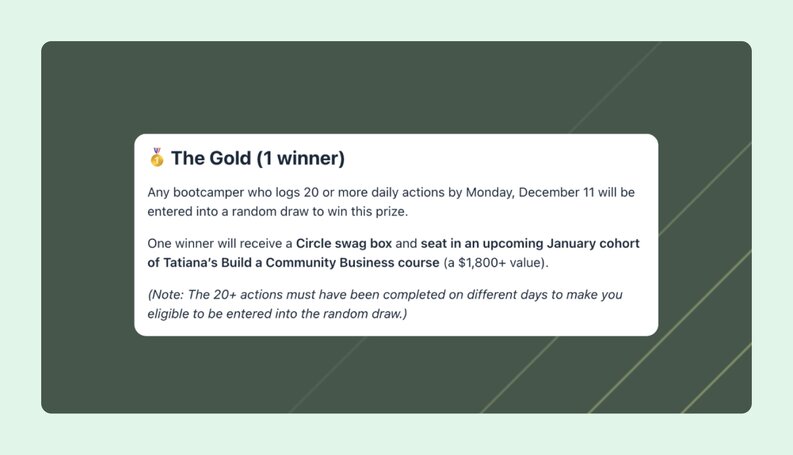
Plan how you’ll measure success and create internal alignment
This is the “crossing your T’s and dotting your I’s” stage of designing a cohort learning experience.
These might seem like minor steps, but you’ll be glad you spent time here once you move into execution mode. It’s time to figure out how you’ll measure the success of your efforts and rally relevant team members around the project!
➡️ How will you measure success?
In other words: What metrics will tell you whether or not you’ve achieved your goals?
- Will you look at new posts and comments each week?
- What about event RSVPs, attendance, attendance rate (the total number of members who RSVPed over those who actually attended)?
It can be helpful to track how your members engage with different cohort program touchpoints and how that engagement changes over time.
Here’s a behind the scenes peek at our metrics tracker for CGC. You’ll notice a drop in engagement with our different cohort touchpoints in weeks 3 and 4 (compared to weeks 1 and 2). This is pretty normal and to be expected — it’s consistent with what we’ve seen in our previous bootcamp experiences. But it also got us thinking about testing shorter program formats, which we’re starting to experiment with to see if we can deliver quicker wins to participants while keeping them more engaged throughout.
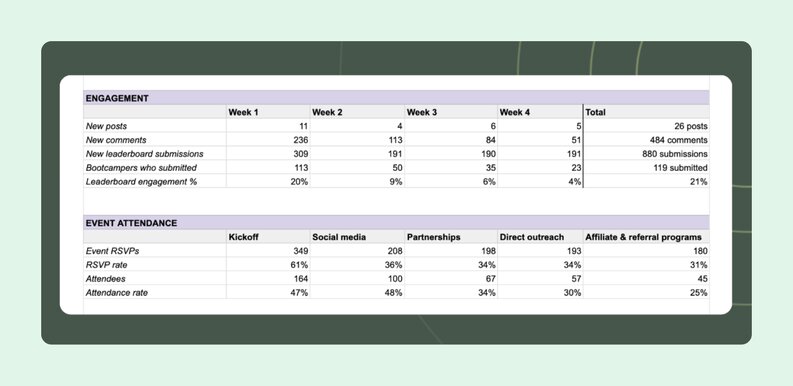
➡️ Whose alignment do you need before you can move forward?
Do you need to create any alignment or buy-in with your team before moving forward? Are you a community builder or founder who needs to rally a team around executing your vision? Are you a community manager who needs approval from someone higher up?
If you’re a one-person show, this probably doesn’t apply to you. But if you work with a team, now is the time to start thinking about who else has a stake in the project and how you’ll loop them in. These individuals might offer helpful perspectives that end up changing the scope of the project, so you’ll want to start this process as early as possible.
Outline your content creation game plan
We’re almost at the end of the design phase! Before moving forward, you’ll want to map out a plan for creating any program-specific content. It’s a good idea to refer back to the touchpoints you identified earlier as they’ll give you a strong sense of the types of content you’ll need to create.
➡️ What assets will you need to create to deliver the experience?
This could include any async course content, masterclass or live session presentations, supplemental workbooks or templates etc. You might also consider any material you’ll create for your resource library, such as an FAQ post or a “how to participate in this cohort program” post.
➡️ Brainstorm discussion prompts, thought starters, and calls to action.
In between any live touchpoints, you’ll want to keep cohort programers as engaged and plugged into the experience as possible. Starting discussions and encouraging members to respond to some prompt or call to action is a great way to achieve this. It’s also a great way to facilitate connections among your members. It can be helpful to start brainstorming these now, and worth adding “discussion prompts” to your list of assets to create!
Check out this great discussion starter from Tatiana in our CGC discussion space.
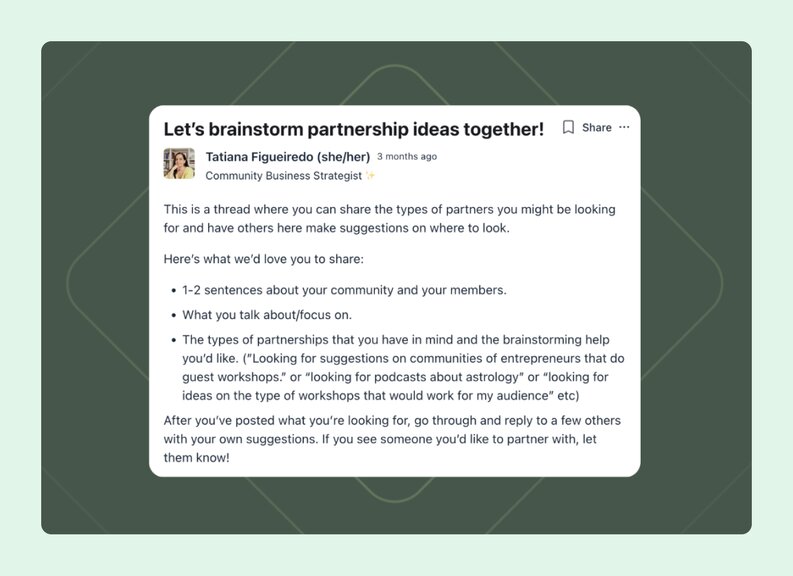
Map out your cohort program spaces
This is the final step of the design phase: It’s time to put the infrastructure in place to actually deliver your cohort experience to members.
Luckily, this couldn’t be easier with Circle. 😆 If you don’t have a community on Circle yet, try our 14-day free trial!
➡️ What spaces do you need to build to deliver this experience?
This might include a discussion space where members can connect and share updates on their progress, an event space where they can RSVP to any live sessions, and some sort of resource library where they can easily access any important program materials or information.
We created a resource library space for CGC, and I’d highly recommend it! We used it to highlight general information about the cohort program, outline how to win prizes, share a supplemental workbook, upload replays of the live sessions, and more.
You can go ahead and create these spaces now, or slot them into your content creation game plan.
(Looking for help setting up your spaces? Check out our product tutorials.)
How to launch a cohort program and get the right members to join
Once you’ve planned your cohort program, you can turn your focus toward launching it. I’m going to walk through how to communicate the value of your program, promote it, and inspire your people to join.
Craft your key messaging
If you want members to join your cohort program, you’ll need to be able to articulate what’s in it for them. When you’re clear on how you’ll communicate the benefits, drafting any promotional materials will become 10x easier.
Draft your tagline
You’ve already titled your cohort program. Now, you can take things one step further by developing a tagline that clearly and concisely summarizes the experience. Your tagline is effectively your five-second elevator pitch.
Let’s look at an example: In our upcoming Your Community Offering bootcamp with Tom Ross, our tagline is: “Uncover your community’s value proposition and build your unique offer.” This is clear, concise, and communicates the results members can expect to achieve from participating.
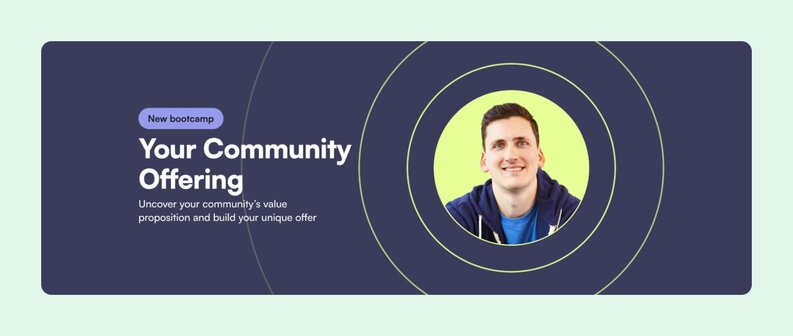
If you’re stumped here, refer back to your notes from earlier and, in particular, your response to this prompt: “What outcome do you hope to deliver to participants through this cohort program?”
List out the benefits of participating
This can just be a quick, bulleted list. You’ll want to hit on the benefits of participating in any promotional materials you draft, so having them ready to go will save you tons of time in the long run.
Check out the key benefits from participating in the Your Community Offering bootcamp.
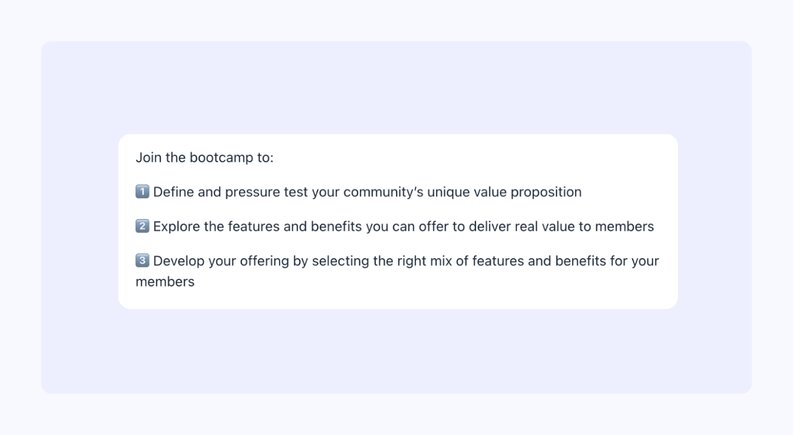
Figure out how members will join
In order to launch your program, you’ll need to create the infrastructure for members to actually opt-in to the experience. While you’re brainstorming about this, keep in mind that your aim is to make it as easy as possible for the right members to join and participate.
Create your invitation link
If your cohort training is accessible to all community members as part of their membership, then your best bet is to have members join through an invitation link. When you create an invitation link, you can bundle access to multiple spaces or all spaces within a specific space group, which can be helpful if your cohort program involves more than one space. When community members click on the invitation link, they’ll unlock access to all of the designated spaces. (Learn more about setting up invitation links in Circle here.)
This is the method we use for our Circle community cohorts. These programs almost always involve multiple spaces, so using an invitation link makes it easy for our members to gain access to all of the cohort spaces. It also means that we don’t have to ask them to join multiple spaces manually.
Set up your paywall
If you plan to monetize your program and sell it as a one-off or recurring cohort, you should look into setting up a paywall to gate the experience. With the paywall, you can gate access to the program spaces and charge existing and/or prospective members for access to the experience.
Note that if you choose to go the paywall route, there’s no need to create an invitation link. (Learn more about paywall setups in Circle here.)
Configure your custom lock screens
For our most recent bootcamp, we leveraged custom lock screens to “force” members to opt-in to the experience. (Learn more about setting up lock screens in Circle here.) We set up the same custom lock screen for each of our program spaces, and included:
- More info about the bootcamp program
- CTA buttons that linked out to our invitation link
Take a peek at our lock screen for the Community Growth Catalyst program below.
For Community Growth Catalyst, the flow to join looked like this:
- In all of our promotional materials, we linked out to the main program discussion space
- Members who clicked that link were brought to the custom lock screen, where they could then learn more about the cohort and join by clicking the “Join now” button
- The “Join now” button was linked to our invitation link for the program, so when a member clicked on it, they’d unlock access to all three cohort spaces
We did this to make sure that any member joining the program spaces demonstrated high intent to participate. We could’ve simply linked directly to our invitation link in all of our promotional comms, but the risk there is that some members will click the link out of curiosity rather than any real intent to participate.
Promoting your cohort program
Congratulations: You have all the groundwork in place to officially start promoting your cohort program!
In this section, we’ll look at different ways you might choose to promote your program to members. I’d encourage you to pick and choose the strategies that feel most compelling to you, as not all of them will work for your specific use case.
Publish an announcement post
Whether you’re making your cohort available to all members or selling it individually, you should announce to your community that it’s happening. Aim to announce your program several weeks before it actually kicks off to give your members time to 1) decide if they want to join and 2) block off their calendars so they can actually participate.
For cohort programs in the Circle community, we’ve always announced them via a dedicated post in our announcements space.
At a high level, your announcement post should address:
- What’s happening and when
- What participants will get out of the cohort experience
- An overview of how the program works
- Details on how to join
- Answers to FAQ (What’s the time commitment? Where will this take place? Etc)
Feature in your newsletter and/or Weekly Digest
At Circle, we use the custom introduction of our Weekly Digest to promote specific programs and events, including any cohort trainings we have coming up. (Learn more about setting up your own Weekly Digest here.)
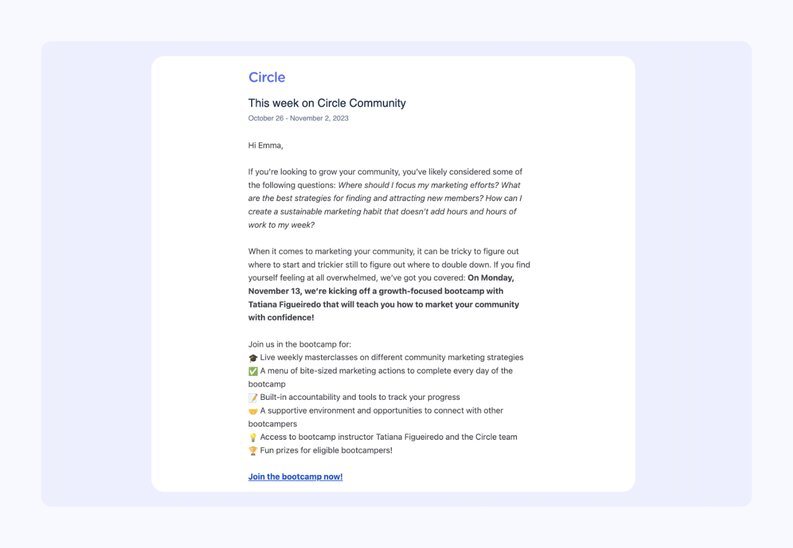
Execute an outreach campaign
If there are specific community members who you think would be a great fit for your cohort, try reaching out to them individually via direct message. You can also do this at scale by using workflows to send an automated DM to specific groups of members. (Perhaps most helpful for this use case: With workflows, you can send a DM to all members in a specific space or all members who attended a specific event).
For our Community Growth Catalyst cohort experience, we used workflows to DM members who had joined our previous programs.
Promote at live events
If you’re already hosting live events in your community, you can carve out a few minutes at the beginning or end to mention your upcoming cohort, bootcamp, etc. When we’re promoting a new cohort in the Circle community, we’ll typically create a slide about the program that we can share at our regular live sessions (office hours, masterclasses, workshops, and so on).
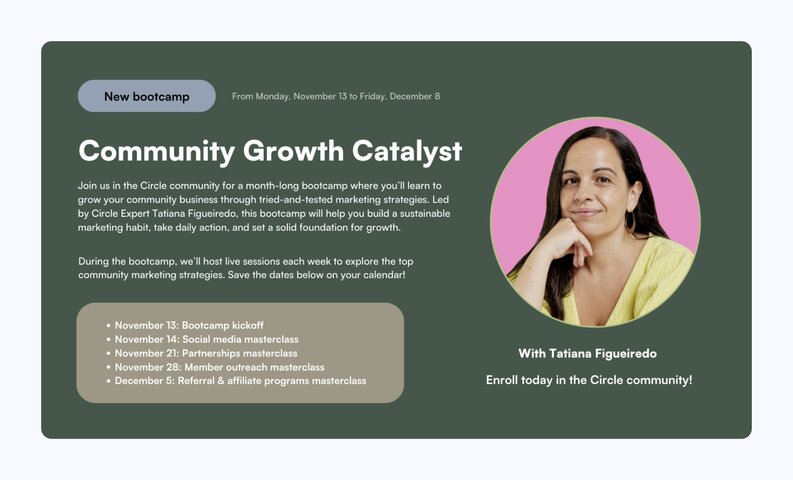
How to host a cohort program that keeps member engaged and moving forward
You’ve planned your cohort, you’ve launched it, and now it’s time to actually host it!
We’ll explore different types of activities you might want to complete as you guide members through your cohort experience. Exactly how you host your program will depend on your unique format and structure, so feel free to leverage the strategies in this post that are most relevant to you and leave the ones that aren’t. Let’s get into it!
Facilitate the experience
Moderate the discussion
You should make it a point to regularly check in on any cohort-related discussions, whether those are happening in a dedicated discussion space, on an event description, or somewhere else. Block off time each day to check in on these conversations, and aim to answer questions, offer guidance and suggestions, and cheer on your cohort programers in a timely manner.
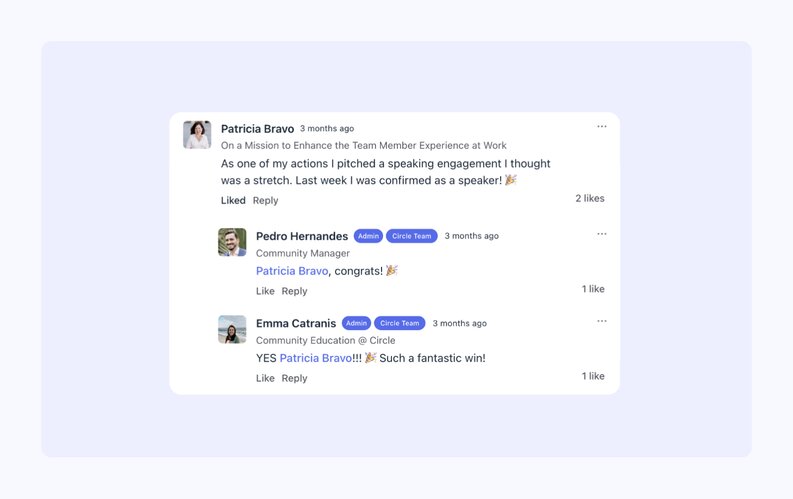
Host your live sessions
This one is a bit obvious, but if your cohort training includes live sessions, you’ll need to set aside ample time to prepare for and host those. If you’re new to hosting events or you’re simply looking to brush up on your facilitation skills, be sure to check out this great blog post from Circle contributor, Gwyn Wansbrough.
Share replays of live sessions
Once you’ve hosted a live session for your cohort program, aim to make a replay of it available within 24 hours. This is helpful for members who weren’t able to attend live, or those who want to revisit an insight or topic from the session. We created a Resource Library space for our last cohort, which is where we published replays of our live sessions.
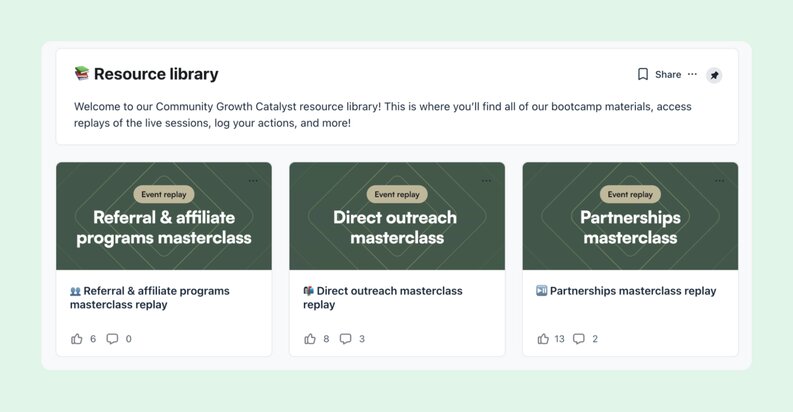
Keep members engaged
Spark discussion
Remember those discussion prompts and thought starters you brainstormed earlier? It’s time to pull those out!
Choose a prompt that you feel would spark interesting discussion among your members, and draft a post around that prompt. In this post, you should share some of your own insights and include a call-to-action asking members to respond to the prompt. This can be a great way to engage members and encourage them to share their own thoughts and insights.
Execute a re-engagement campaign
Are you noticing that certain cohort members are falling behind or becoming disengaged? If so, it might be time to execute a re-engagement campaign.
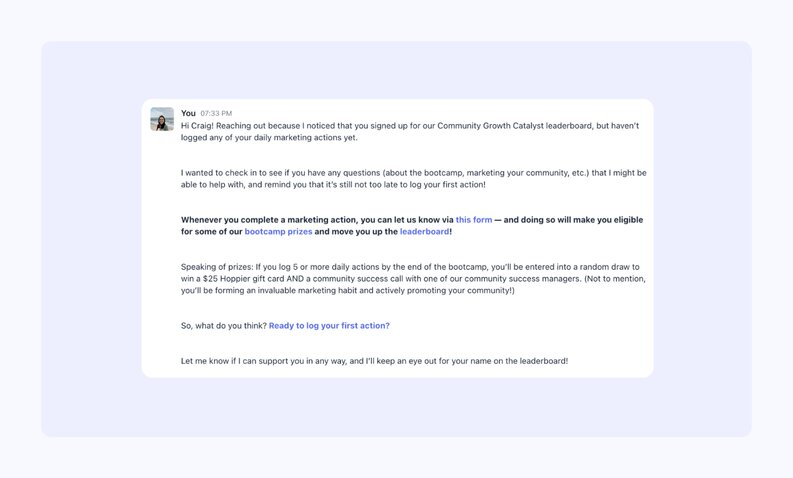
Here are the steps I recommend following…
- Identify the grounds for re-engagement: In our Community Growth Catalyst cohort, we determined that our best candidates for re-engagement were cohort programers who signed up for our leaderboard but failed to take further action by the time we were halfway through the experience.
- Create an outreach list: Once we identified the criteria for re-engagement, we compiled a shortlist of any cohort programers who met that criteria. This gave a clear picture of who was falling behind and who we should reach out to.
- Conduct outreach: Then, we sent a direct message to each cohort programer on our outreach list. In each message, we mentioned to the recipient that we’re totally available for questions and support, encouraged them to plug back into the experience by completing one simple action, and reminded them of the incentives for doing so.
Measurement, reporting, and reflection
Record your key metrics
You already identified the key metrics that will tell you whether or not you’ve achieved your program goals. But when you’re in the midst of actually hosting your cohort experience, you most likely won’t remember to keep track of those. Do your future self a favor and block off time on your calendar or set yourself daily or weekly reminders to record your key metrics (things like new posts and comments, event RSVPs and attendance, and so on).
Survey your members
We close out each of our bootcamps in the Circle community with a feedback survey, where we ask members to tell us what they liked about the experience and what we could’ve improved on. We also ask them to share details about any results they’ve achieved through each cohort program.
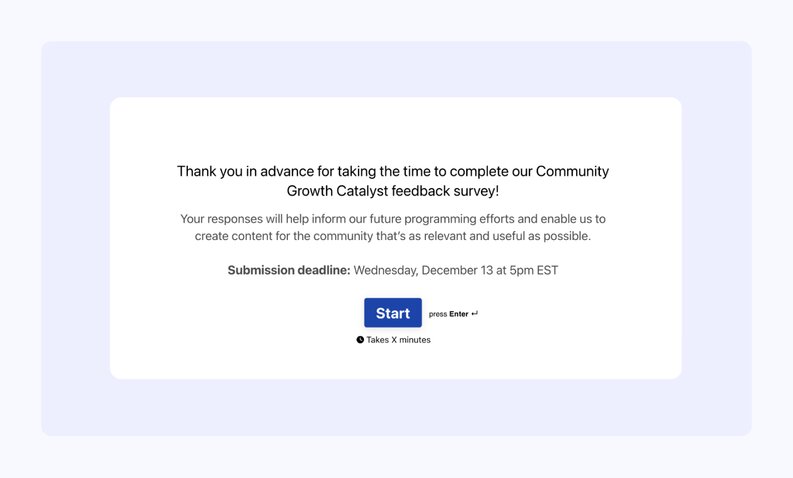
Feel free to steal some of our favorite survey questions:
- How would you rate the cohort program overall? [Scale of 1-10]
- Briefly explain why you selected that rating. [Text response]
- Which cohort touchpoints did you engage with? [Multiple select: List your touchpoints]
- Which cohort touchpoint did you find MOST helpful? [Single select: List your touchpoints]
- Which cohort touchpoint did you find LEAST helpful? [Single select: List your touchpoints]
- Briefly describe your greatest accomplishment or win from participating in the cohort learning experience. [Text response]
- Do you have any additional feedback to share? [Text response]
Conduct a retrospective
After we’ve collected feedback from program participants, our team also likes to conduct a retrospective, which just means that we do a deep dive into what worked, what didn’t, and what we’re going change or improve for next time. It’s a great opportunity to think critically about the end-to-end experience of planning, launching, and hosting a cohort program and share our learnings with the broader team.
And that’s it for this guide on planning, launching, and hosting a cohort program!